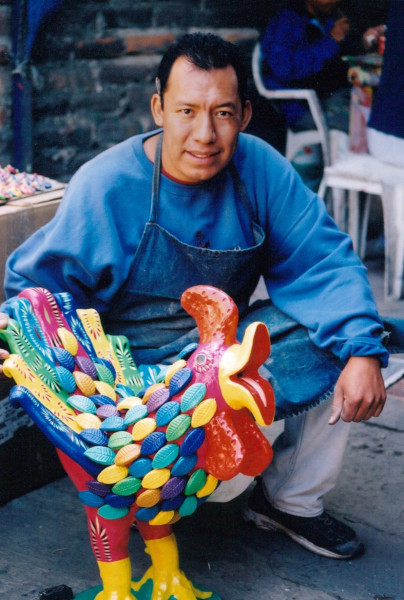Product Description
Gerardo Ortega - Mexican Folk Art, Rooster on Chair Drinking a Beer, 9" x 3.5" x 4" Ortega 42
The Ortega family has been working in Barro Betus for four generations. This is also called "Fantastic Ceramics" because of the bright colors used, barro betus gets its name from the oil bath it receives in aceite de betus (oil of betus - a resin extracted from the pine tree) before it is fired.
The process begins with "tortillando" or kneading the clay into unique shapes. The kiln is readied and fires pieces created several days before. Before firing, the clay is black. The pieces have to be dried in the open air before baking them or they will explode. The firing is done at a very low temperature compared to other types of ceramics. Each figure is rubbed with birch oil just before firing, giving them a lacquered appearance once finished. Kilns are simple brick holes covered with old tiles.
The village of Santa Cruz de las Huertas, Jalisco is the only village that makes barro betus which is one of the seven traditional ceramic techniques that Tonalá has become famous for.
Artist Bio

Gerardo Ortega
The Ortega Family who are renowned for their 100% hand-crafted 'betus' technique using simple 'barro' (clay) to create the most colorful, whimsical, surreal art of imagination. This technique has been passed to 5 generations of the Ortega family, 2 of which currently run the operation - the older 'hermano' (brother) Gerardo is the 'Gerente General' and then the other brothers Oscar and Eleutario oversee production and painting. The sons, daughters, nephews, and nieces who range in age of 16-30 work in production, design, and painting. It is truly a family operation. Their home in Santa Cruz de las Huertas is one in same their "taller" (workshop). The creative process starts from the fine clay powder which they mix with water to create the clay which ends up a very dark brown color, then they mold all of the individual pieces needed to create a design and then piece them together, then the design is left to dry in the sun for 2 days, then they paint the designs and finally fire them in the kiln.










